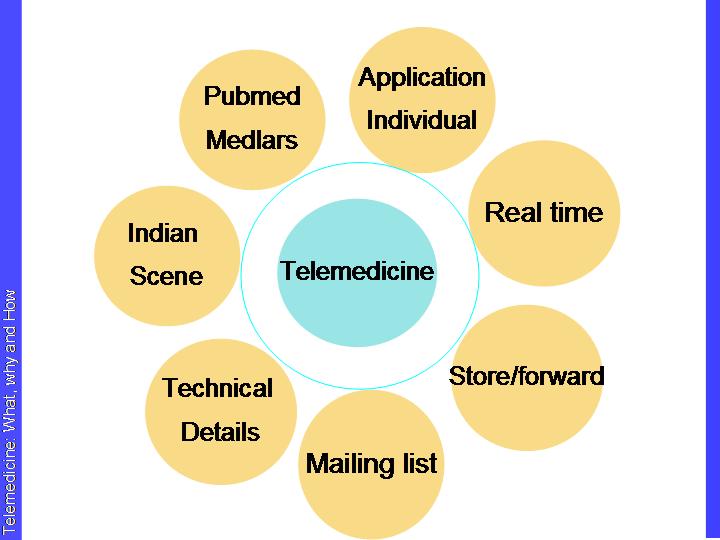Telemedicine: What, Why and How?
Dr. Sachin Kale, MD (Pathology)
The word telemedicine conjures up images of complicated technology, impractical and beyond reach of most health care providers in our country. This presentation will endeavor to demystify telemedicine, by enlightening the what, why and how of telemedicine.

Telemedicine is a rapidly developing application of clinical medicine where medical information is transferred via telephone, the Internet or other networks for the purpose of consulting, and sometimes remote medical procedures or examinations.
There are two types 1. Real time (Synchronous) and 2. store and forward (asynchronous)
Real time telemedicine requires the presence of both parties at the same time, a communications link between them that allows a real-time interaction to take place. Use of some kind of video-conferencing equipment is common. Some peripheral devices like telestethoscope, can be attached to computers or the video-conferencing equipment and they can aid in an interactive examination. A tele-stethoscope allows the consulting remote physician to hear the patient's heartbeat.
Store And Forward telemedicine Involves acquiring medical data (like medical images, biosignals etc) and transmitting this data to a doctor or medical specialist at a convenient time for assessment offline. It does not require the presence of both parties at the same time.
Easiest way to do Store and Forward telemedicine is through emails. Images and other data can be sent as an attachment to email. It involves finding an online group where such activities are taking place.
For Real time telemedicine hardware setup includes a PC, communication link (Dial up, broadband internet or satellite link), and equipment for capturing patient data, like digital or video camera, printer/scanner, and also a videoconferencing system at the patient end. At the doctor end where the patient data is received, analyzed and opinion is given by expert also needs a PC, communication link (Dial up, broadband internet or satellite link), videoconferencing system.
Real time telemedicine can involve a single link between patient end and a single specialist or it can involve the single patient end and multiple specialist ends. First is called Point to Point System, second is called Point to Multipoint System.
Real time telemedicine can be used for CME purpose also, where a presentation can be delivered and students located at distant site can participate and interact remotely.
Such recorded webcasts are available at many websites readily. Several reputed universities of the world have made their academic activities available online, and we can see many of these webcasts anytime, any where, any number of times free of charge. Not only that we can download these webcasts to our smart phones and see it at our convenience.
Telemedicine has special use in developing countries. Where there is shortage of general practitioners, where many rural clinics are run by nurses only, thre is shortage of medical specialists, and many villages have no specialists, etc.
Telemedicine movement in India is spearheaded by institutions like ISRO, Apollo Hospitals, SGPGI in Lucknow, SRMC in Chennai, AIMS in Kochi, and Narayana Hrudayalaya in Bangalore.
With advances and ready availability of technology, there is lot of interest throughout the world in telemedicine. People have used it to give home care to elderly, they have tried to interface mobile phones to electronic health records for monitoring the health of the individual, intensivists have monitored multiple ICUs through central control unit, giving birth to the concept of eICUs
In the not too distant future, it might be possible for patients to connect in their own home with a health care provider located at a distant site. These patients could be examined, have their conditions diagnosed, and receive treatment (e-mail prescription sent to an on-line pharmacy) using their personal computer and an Internet based secure Web site without ever having to leave the bedroom.
Till that happens, a small-time doctor working in resource poor setting can take help of simple tools like a PC, now cheaply available Internet connection; and use telemedicine to interact with colleagues and experts from India and around the world to improve patient care and improve their own professional expertise. This can be one of the most satisfying experience.
According to Institute of Medicine, telemedicine is the use of electronic information and communications technologies to provide and support health care when distance separates the participants.
Going by this definition, if telemedicine is using electronic information for patient care, then we can not neglect the vast online resource of medical knowledge, which we can use to solve our day to day problems and which is available right at your finger tip or your mouse tip if you may! At the click of a mouse. Hence I think it wont be out place here to discuss little bit about how to find right information at right time.
Hence we should develop expertise for searching online material through search engines, medical databases like Pubmed, High Wire press, Google Scholar etc.
Hope is that telemedicine technology can help us make better doctors, giving better care to our patients.
***